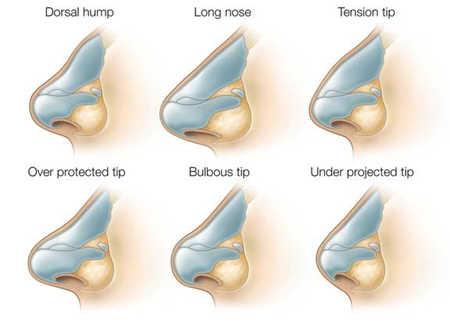Rhinoplasty
Updated May 2024
Robert M. Schwarcz, MD, FACS; D. Julian De Silva, MBBS, MD, FACS
Common indications
- Aesthetic: Large nose, nasal hump, wide nose, droopy nasal tip (Figure 1)
- Functional: Difficult breathing and deviated septum
- Congenital: Cleft lip and palate, congenital nasal abnormalities
- Traumatic nasal fracture
- Inflammatory conditions: connective tissue disorders, immune disorders
- Iatrogenic: recreational drug use, cocaine

Figure 1. Rhinoplasty candidates.
Anatomical structures
- Cartilages
- Lower lateral cartilages (Figure 2)
- Upper lateral cartilages
- Septal cartilage
- Nasal bones
- Nasal superficial muscular aponeurotic system (SMAS)
- Soft tissue envelope beneath skin and above bone and cartilage
- Continuous with SMAS layer of forehead
- Skin envelope

Figure 2. Caption.
Directional anatomical terms
- Rotation versus counter-rotation (Figure 3)
- Projection versus deprojection
- Dorsal versus caudal
 Figure 3. Caption.
Figure 3. Caption.
Types of rhinoplasty
- Surgical
- Open: skin incision in columellar base of nose
- Closed: no exterior incision, interior incision hidden from external view
- Nonsurgical: fillers used to augment nose
Anaesthesia
- General
- Sedation
- Local with adrenaline used to reduce hemorrhage and dissect tissue planes
Open-procedure stages
- Packing of nasal cavity with vasoconstrictor
- Septoplasty if required
- Full transfixation incision
- Partial transfixation incision
- Killian incision (Figure 4)
- Mid-columellar incision
- Bilateral marginal incisions
- Tip surgery including tip augmentation, elevation, support, projection, commonly cephalic trim of lower lateral cartilages
- Nasal dorsum: commonly reduction of hump
- Alteration of projection
- Deprojection (Figure 2)
- Increased projection with grafts
- Osteotomies to narrow nasal bones
- Transcutaneous versus endonasal osteotomies
- Lateral and medial osteotomies
- Shape of osteotomy, e.g., high to low
- Closure of skin and mucosa
- Alar reduction if required
- Packing of nose internally if required
- Splinting of nose with thermoplastic splint

Figure 4. Killian incision.
Graft tissue types
- Autologous
- Septal cartilage
- Auricular cartilage
- Costal cartilage
- Nonautologous
- Silicone
- Medpore
- Gortex
Complications
- Intraoperative complications
- Hemorrhage
- Collapse of boney pyramid
- Osteotomies
- Rocker deformity: This deformity results when the medial osteotomy creates a fracture higher in the thicker part of the nasal bones, resulting in loose nasal bones.
- Open roof deformity: After reduction of a nasal hump, the bones are insufficiently narrowed, resulting in a wide nasal dorsum.
- Step deformity: Uneven reduction in nasal bones resulting in visible boney ridge
- Trauma/tears: skin, mucoperichondrium, septum
- Early postoperative complications
- Hemorrhage
- Epistaxis
- Septal hematoma
- Swelling
- Infection
- Skin necrosis
- Cerebrospinal fluid rhinorrhea
- Numbness and pain
- Transient episodes of anxiety or depression
- Late postoperative complications
- Polly beak nasal deformity
- Septal perforation (3%-25%)
- Tip: Nasal bossae, droop, hanging columella
- Aesthetic misjudgments
- Scarring
- Revision rhinoplasty 5-15%
- Persistent psychological complications
References and additional resources
- Azizzadeh et al. Master techniques in rhinoplasty. Elsevier. 2011
- Gall R, Blakley B, Warrington R, Bell DD. Intraoperative anaphylactic shock from bacitracin nasal packing after septorhinoplasty. Anesthesiology. Nov 1999;91(5):1545-1547.
- Hallock GG, Trier WC. Cerebrospinal fluid rhinorrhea following rhinoplasty. Plast Reconstr Surg. Jan 1983;71(1):109-113.
- Sarwer DB, Pertschuk MJ, Wadden TA, Whitaker LA. Psychological investigations in cosmetic surgery: a look back and a look ahead. Plast Reconstr Surg. Apr 1998;101(4):1136-1142.
- Anderson JR, Ries WR. Rhinoplasty: Emphasizing the External Approach. New York: Thieme Inc;1986.
- Lawson W, Kessler S, Biller HF. Unusual and fatal complications of rhinoplasty. Arch Otolaryngol. Mar 1983;109(3):164-169.
- McCollough EG. Nasal Plastic Surgery. Philadelphia: WB Saunders;1994.
- Rees TD, Krupp S, Wood-Smith D. Secondary rhinoplasty. Plast Reconstr Surg. Oct 1970;46(4):332-340.
- Tebbetts JB. Primary Rhinoplasty: A New Approach to the Logic and Techniques. St Louis, Missouri: Mosby Inc; 1998.
- Teichgraeber JF, Riley WB, Parks DH. Nasal surgery complications. Plast Reconstr Surg. Apr 1990;85(4):527-531.
- Safe II, Sadek EY, Surgical importance of Nasal SMAS in Open Rhinoplasty. Egypt J Plast Reconst Surg. 2010; 34(1) Jan 135-138.
- Becker DG, Ransom E, Guy C, Bloom J. Surgical Treatment of Nasal Obstruction in Rhinoplasty. Aesthetic Surgery Journal. May/June 2010 vol. 30 no. 3 347-378.
